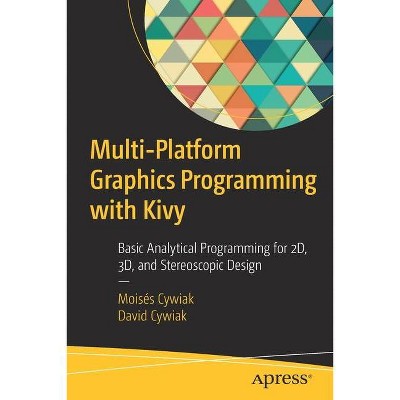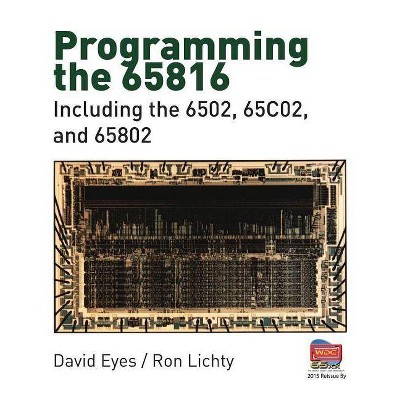Multi-Platform Graphics Programming with Kivy - by Moisés Cywiak & David Cywiak (Paperback)

Similar Products
Products of same category from the store
AllProduct info
<p/><br></br><p><b> Book Synopsis </b></p></br></br><p>Modern science requires computer graphics models to provide realistic visual renderings. Learning the appropriate programming tools for 2D and 3D modeling doesn't have to be so difficult. This book reviews the best programming tools to achieve this and explains how to apply them to mobile platforms like Android. </p> <p><i>Multi-Platform Graphics Programming with Kivy</i> provides a straightforward introductory approach for designing 2D, 3D, and stereoscopic applications, using analytical equations from vector algebra. Throughout the book you'll look closely at this approach and develop scenes in Kivy, taking advantage of powerful mathematical functions for arrays by NumPy for Python. </p> <p>Unbuntu is used to develop the programs, which allows you to easily convert to Android platform. Each chapter contains step-by-step descriptions on each subject and provides complete program listings.</p><b><br></b><b>What You'll Learn</b><ul><li>Work with Kivy, a modern, powerful multi-platform graphics system</li><li>Convert and run programs on Android devices</li><li>Program, fill faces, and rotate 2D and 3D polygons</li><li>Apply the concepts of 2D and 3D applications</li><li>Develop stereoscopic scenes</li><li>Review a straightforward introduction to 2D, 3D, and stereoscopic graphics applications</li><li>Use simple analytical equations from vector algebra</li></ul><b>Who This Book Is For</b><br><b><br></b>The primary audience is students and researchers in graphics programming with experience in analytical equations.<p/><br></br><p><b> From the Back Cover </b></p></br></br>Modern science requires computer graphics models to provide realistic visual renderings. Learning the appropriate programming tools for 2D and 3D modeling doesn't have to be so difficult. This book reviews the best programming tools to achieve this and explains how to apply them to mobile platforms like Android. <p><i>Multi-Platform Graphics Programming with Kivy</i> provides a straightforward introductory approach for designing 2D, 3D, and stereoscopic applications, using analytical equations from vector algebra. Throughout the book you'll look closely at this approach and develop scenes in Kivy, taking advantage of powerful mathematical functions for arrays by NumPy for Python. </p><p>Unbuntu is used to develop the programs, which allows you to easily convert to Android platform. Each chapter contains step-by-step descriptions on each subject and provides complete program listings.</p><br>You will: <ul><li>Work with Kivy, a modern, powerful multi-platform graphics system</li><li>Convert and run programs on Android devices</li><li>Program, fill faces, and rotate 2D and 3D polygons</li><li>Apply the concepts of 2D and 3D applications</li><li>Develop stereoscopic scenes</li><li>Review a straightforward introduction to 2D, 3D, and stereoscopic graphics applications</li><li>Use simple analytical equations from vector algebra</li></ul><p/><br></br><p><b> About the Author </b></p></br></br><p>Moisés Cywiak is a researcher in physical optical sciences with over 20 years of teaching experience in physics, mathematics, electronic engineering, and programming in C, C++, and python, in Centro de Investigaciones en Óptica A.C.</p>David Cywiak received his Ph.D. degree in physics in 2014 from Universidad de Guanajuato. From 2012 to 2013 he collaborated as a guest researcher at the Dalton Cardiovascular Research Center, University of Missouri-Columbia, in the development of an optical-photoacoustic system intended for the detection of photoacoustic signals generated by cancerous cells. Since 2014 he has been working as a metrologist in the Thermometry Department at Centro Nacional de Metrologia, México. His research includes photoacoustics, optical engineering and radiation thermometry. He has over 7 years of experience teaching physics, mathematics and programming in C for undergraduate students. He also has over 5 years of experience teaching Temperature measurement techniques and calibration of instruments in the thermometry area for industry professionals. <br>
Price History
Cheapest price in the interval: 27.99 on October 27, 2021
Most expensive price in the interval: 29.99 on December 20, 2021
Price Archive shows prices from various stores, lets you see history and find the cheapest. There is no actual sale on the website. For all support, inquiry and suggestion messagescommunication@pricearchive.us




















